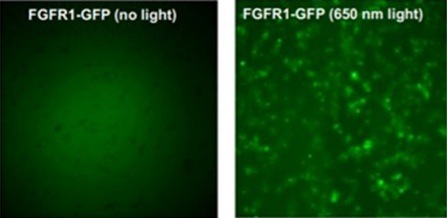
Researchers from the University at Buffalo recently managed to control a gene that is essential in the human growth process using light. This innovative work was done in lab-grown brain tissue and has the potential to create new cancer treatments and manage mental disorders like schizophrenia, the authors say. This work was led by UB researchers Josep M. Jornet, Michal K. Stachowiak, Yongho Bae and Ewa K. Stachowiak, and was published in Proceedings of the Institute of Electrical and Electronics Engineers.
The researchers note that this approach is pushing forward gene manipulation, posing potential treatments for various diseases. The approach focuses on controlling human genes using nanotechnology and laser lights, a technique they are calling optogenomics.
“The potential of optogenomic interfaces is enormous,” says co-author Josep M. Jornet, PhD. “It could drastically reduce the need for medicinal drugs and other therapies for certain illnesses. It could also change how humans interact with machines.” Jornet also serves as an associate professor in the Department of Electrical Engineering in the UB School of Engineering and Applied Sciences.
By using light to control cellular interactions, researchers can potentially treat diseases by fixing miscommunications occurring between different cells. This UB research team decided to focus on the Fibroblast Growth Factor Receptor 1 (FGFR1) in their study, being that this gene controls about 4,500 other genes. This accounts for roughly 20% of the human genome, making FGFR1 a “boss gene” in the eyes of Michal K. Stachowiak, PhD.
“By controlling FGFR1, one can theoretically prevent widespread gene dysregulations in schizophrenia or in breast cancer and other types of cancer,” explained Stachowiak, professor in the Department of Pathology and Anatomical Sciences in the Jacobs School of Medicine and Biomedical Sciences at UB.

Using small photonic brain implants, the researchers were able to wirelessly manipulate FGFR1 with nano lasers and antennas. These implants were inserted into experimental brain tissue that they created using induced pluripotent stem cells and incorporated light-activated molecular features. This combination allowed the team to activate and deactivate the FGFR1 gene and inherently, its biological functions. This approach could eventually lead to the manipulation of a patient’s genomic structure and give physicians a way to correct abnormalities, according to Stachowiak.
Going forward, the researchers plan to test their approach in 3D models of the brain as well as in cancerous tissue. Though this approach is far from ready to be implemented into the clinical setting, the team is optimistic about these future studies.
More on Optogenomics
This year, the Warren Alpert Foundation Prize for medical research was awarded to researchers who applied optogenetics to control brain function of a fruit fly. This work marked a breakthrough in neuroscience, with light being used to control brain activity.
“Their discoveries established the field of optogenetics, propelled it forward, and laid the foundation for optogenetic-based therapies for disorders ranging from Parkinson’s to addiction,” announced the foundation, who works with Harvard Medical School.
This $500,000 prize was awarded to Ed Boyden, Peter Hegemann, Gero Miesenböck and Karl Deisseroth.
Optogenomics- An innovative way of controlling, manipulating, and directing the human genome by virtue of nanotechnology combined with laser light.@amitabhk87@CSIR_IND@FollowNibmg@DBTIndiahttps://t.co/zWLPOsjubO
— Anshuman Gaur (@anshumangaur) July 22, 2019







 © 2025 Mashup Media, LLC, a Formedics Property. All Rights Reserved.
© 2025 Mashup Media, LLC, a Formedics Property. All Rights Reserved.